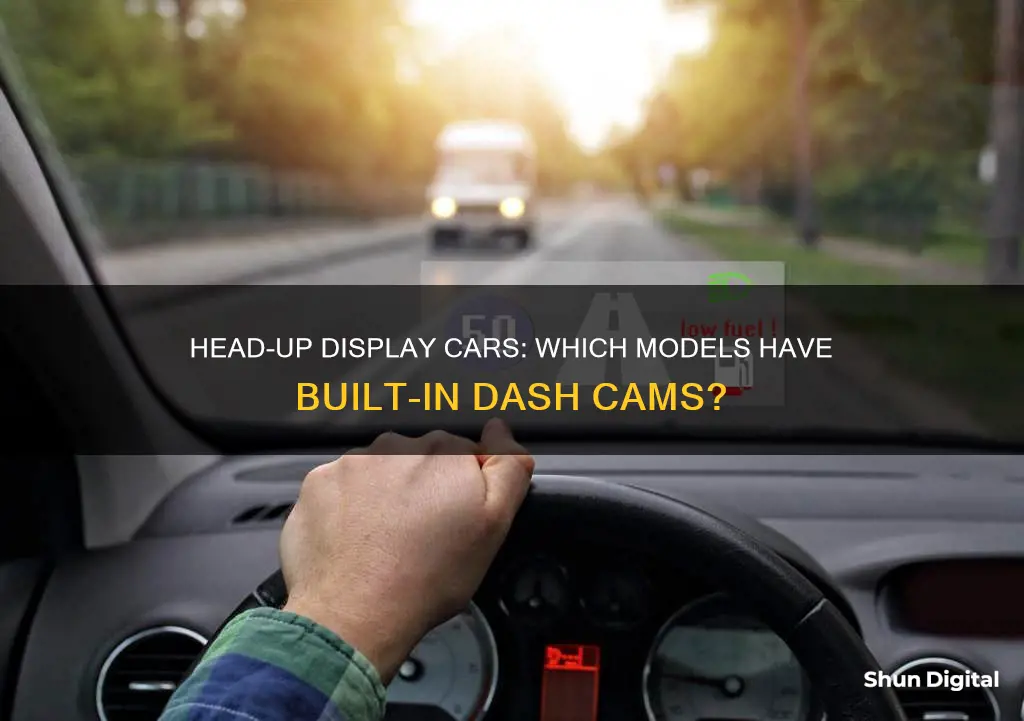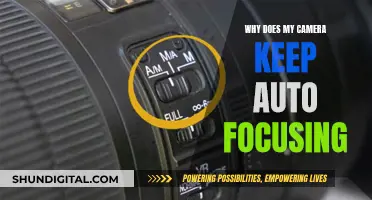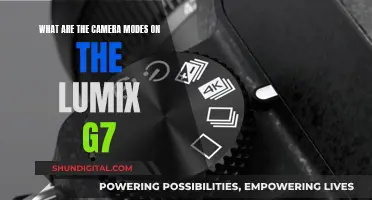
Head-up displays (HUDs) are an innovative feature in the automotive industry, projecting data like speed, navigation, and vehicle performance directly into the driver's line of sight. This technology, originally designed for aircraft, improves safety by reducing the need for drivers to look away from the road. While some newer car models have built-in HUDs, there are also aftermarket options available for older vehicles. These aftermarket HUDs vary in price and features, with some offering phone connectivity and others providing basic data like speed and mileage. Additionally, dashboard cameras have become popular for recording journeys and aiding with parking and blind spots. When choosing a HUD, factors such as display type, installation, connectivity, and data projection should be considered to ensure a safe and enjoyable driving experience.
What You'll Learn

Luxury car HUDs: Audi, Bentley, Porsche, Rolls-Royce, etc
Luxury car manufacturers have been incorporating head-up displays (HUDs) and dashboard cameras into their vehicles to enhance the driving experience and provide advanced safety features. Here's a look at how some prestigious brands like Audi, Bentley, Porsche, and Rolls-Royce have integrated these technologies into their vehicles:
Audi
Audi is known for its innovative use of technology in its vehicles, and its HUD system is a testament to that. The Audi virtual cockpit is a fully digital instrument cluster with a 12.3-inch TFT screen that displays information such as speed, navigation, media, and driver assistance systems. The HUD projects relevant information directly into the driver's line of sight, including navigation directions and warning messages. Additionally, Audi offers a variety of infotainment systems with high-resolution displays, intuitive voice controls, and touchpad interfaces. The MMI touch response system, for example, features a 10.1-inch touchscreen with haptic feedback and intuitive smartphone-like menu navigation.
Bentley
Bentley takes a unique approach to the dashboard with its rotating dashboard design. This ingenious mechanism allows the driver to switch between a touchscreen infotainment system and three analogue dials or a blank veneer at the touch of a button. The rotating dashboard is a clever way to declutter the cabin and create a timeless aesthetic. While the touchscreen provides modern functionality, the analogue dials offer a classic look and include features like a thermometer, a compass, and a chronometer. This option adds a distinctive touch to the Bentley's interior, ensuring it remains elegant and functional.
Porsche
The Porsche Taycan offers an optional $1850 HUD that projects essential driving information directly in front of the driver, eliminating the need to look down at the dashboard. This feature is especially useful when navigating winding roads, as drivers can keep their eyes on the road while still accessing speed, navigation, and other critical data. While some drivers find the HUD superfluous, particularly with CarPlay integration, others appreciate its practicality and gimmickry. Porsche also offers other advanced features like rear-wheel steering and surround-view cameras.
Rolls-Royce
Rolls-Royce, known for its opulent sedans and SUVs, offers a range of advanced features, including a HUD and a dashboard camera. The Ghost model includes a head-up display that projects speed, navigation directions, and other information onto the windshield, visible only from the driver's sightline. Additionally, the Night Vision system, activated by a half-moon button, includes a hidden infrared camera and dashboard display, capable of detecting pedestrians up to 300 meters away. These features enhance the driving experience and safety, showcasing Rolls-Royce's attention to detail and innovation.
How to Extend Your Camera's Battery Life
You may want to see also

Mid-range car HUDs: Ford, Honda, Hyundai, Mazda, etc
Head-up displays (HUDs) are a form of augmented reality that presents data on a transparent display, allowing users to maintain their usual viewpoint. Initially developed for military aviation in the 1950s, HUDs have since become an option in mid-range car models, including those from Ford, Honda, Hyundai, and Mazda.
Ford
Ford offers HUDs as an option in its F-150 and Super Duty F-250/F-350 models. The F-150 is a popular choice for those seeking a mainstream nameplate with high-end features.
Honda
Honda's Accord Hybrid and Pilot models are equipped with HUDs, providing drivers with essential information like speed and navigation directions.
Hyundai
Hyundai has incorporated HUD technology in its Ioniq 5, Ioniq 6, Palisade, Santa Fe, Santa Fe Hybrid, and Sonata Hybrid models. The All-New Kona is the first Hyundai model to introduce a combiner HUD, projecting relevant driving information directly into the driver's line of sight. This enhances safety by allowing drivers to process information faster while keeping their attention on the road.
Mazda
Mazda's Active Driving Display is designed to keep the driver's eyes on the road by presenting information such as speed and navigation directions within the driver's view, similar to a fighter pilot's cockpit display. This feature is available in the CX-30, CX-5, CX-50, CX-90, and Mazda3 models.
Troubleshooting Camera Sync Issues with Your Computer
You may want to see also

Affordable car HUDs: Pyle, Wiiyii, Dagood, etc
There are a variety of affordable car head-up displays (HUDs) on the market, with prices ranging from $20 to $250. While some basic models only display the car's speed, more advanced HUDs can show a multitude of parameters, including speed, RPM, water temperature, battery voltage, fuel consumption, mileage, and more. Here are some options for affordable car HUDs:
- Pyle PHUD18OBD: This HUD has a 5.5-inch display and combines OBD and GPS data. It offers a bright and large display and can show more than two dozen pieces of automotive information. It costs around $49.99.
- Wiiyii C1 OBD + GPS: This HUD has a self-contained projection screen and combines OBD and GPS data. It displays a wide range of data, including air-to-fuel ratios and turbocharger pressures. It lacks phone integration and navigation features. It costs $56.
- Dagood A8: The Dagood A8 has a large 5.5-inch display and combines GPS and OBD data. It offers bright graphics and a light sensor to automatically adjust brightness. It also has a faux leather finish. While it may interfere with the windshield view at times, the large display makes it easier to see information at a glance. It costs around $45.27.
- Wiiyii P8: This HUD offers two installation options: on the A-Pillar trim or the dashboard. It has a simple setup, connecting to USB power. It offers eight display interfaces and can read car data streams, displaying vehicle ECU data. It supports OBD+GPS dual systems and displays speed, clock, RPM, voltage, water temperature, etc. It costs $45.98.
Charging the Wyze Outdoor Camera: How Long Does It Take?
You may want to see also

Aftermarket HUDs: HUDWAY Drive, Acecar, Sherox, etc
Aftermarket HUDs are a great way to add a head-up display to your vehicle without having to buy a new car. Here are some of the most popular options:
HUDWAY Drive
HUDWAY Drive is a portable head-up display that works with any car. It connects to your smartphone via Bluetooth and can mirror any navigation app, such as Google Maps or Waze. It also has a video input port that allows you to connect up to four cameras, including a rear view and side view cameras, for safer parking and lane changes. The device is designed to merge with your dashboard and can be installed in most cars. However, it may not fit in some models with a slanted windshield. HUDWAY Drive comes in two versions: Pro, which supports video display from connected cameras, and Lite, which does not.
Acecar
The Acecar HUD is a small, rectangular device that sits on your dashboard and displays information on your windshield. It provides basic information such as speed, engine RPM, and mileage, as well as warnings for overheating and low voltage. It plugs into the OBD2 port, so it is not compatible with older cars. However, it also has a GPS mode that can be used in cars without an OBD2 port, which will display the speed only. Acecar offers a 12-month return policy if you are not satisfied with the product.
Sherox
The Sherox HUD is a simple and affordable device that plugs into your car's OBD2 port, displaying basic information such as speed, trip meter, voltage, and coolant temperature. It reflects information directly onto your windshield without the need for a reflection film, using nanotechnology to eliminate double reflections. The device turns on and off with the engine and does not require manual operation or battery drainage concerns. While it may not have as many features as other HUDs, it is a good option for those seeking simplicity and affordability.
The Evolution of Bird's-Eye View Car Cameras
You may want to see also

HUD types: Windshield projection, screen projection, etc
There are two main types of head-up display (HUD) technologies: Projected HUD and Emissive HUD.
Projected HUD
Projected HUD solutions include TFT-/micro-LED-display HUD and DLP projector HUD. These HUDs project images generated from a micro-LED display using two mirrors or a DLP projector, DLP optics, and HUD optics, respectively. The focal point of projected HUDs is adjustable, typically placed a few meters ahead of the driver, allowing for fast eye refocusing. They can display rich and colourful content and have been widely tested and implemented in the automotive market. However, they require a complex setup that occupies a significant amount of space on the dashboard. Projected HUDs also necessitate a special windshield or coating and are unsuitable for vertical windows and windshields in larger vehicles. Additionally, the projected image may shake with vehicle vibrations, resulting in blurry visuals.
Emissive HUD
Emissive HUDs, on the other hand, utilise transparent displays such as micro-LED, TOLED, and LUMINEQ in-glass/polycarbonate displays. These displays are either attached to the windshield or placed above the dashboard as a separate unit. Emissive HUDs have a simpler construction and require significantly less space than projected HUDs. They are also more shock-resistant and suitable for vertical windshields in larger vehicles. LUMINEQ HUDs offer superior optical clarity and transmission, with 80% transparency and up to 70% overall transparency for the laminated stack. However, they currently only display monochrome content. TOLED and mini-LED displays can show colourful images but have issues with clarity and haze.
Close Focus Photography: Capturing Tiny Details with Cameras
You may want to see also
Frequently asked questions
A head-up display (HUD) is a feature in some cars that projects information such as speed and navigation directions in the driver's line of sight above the dashboard. This allows the driver to keep their eyes on the road and reduces distractions.
Yes, many modern cars are now being offered with built-in HUDs as an option or as part of specific trim levels. Some of the car brands that offer this feature include Acura, Audi, BMW, Cadillac, Chevrolet, and Ford.
Yes, there are aftermarket HUD options available that can be installed in your car. These typically connect to your car's OBD-II port or cigarette lighter and can project information onto your windshield or a separate screen.
Some popular options include the HUDWAY Drive, Pyle PHUD180BD, Wiiyii C1 OBD + GPS, Dagood A8, and Acecar HUD. These products offer features such as data integration with your car's computer and phone, GPS navigation, and adjustable displays.
Yes, you can add a dashboard camera to your car as an aftermarket accessory. Some head-up displays, such as the HUDWAY Drive, also offer the ability to connect side and backup cameras for video display. This can enhance your field of vision and improve safety while driving and parking.







